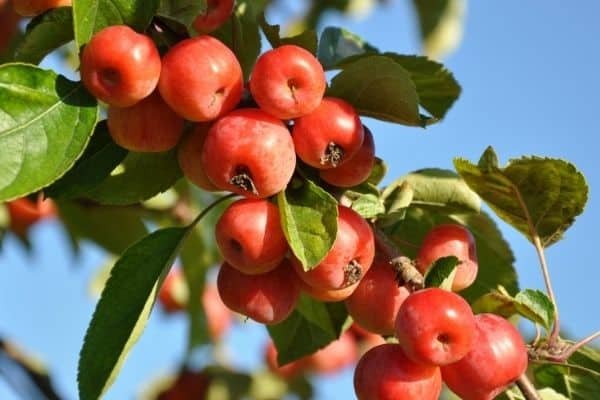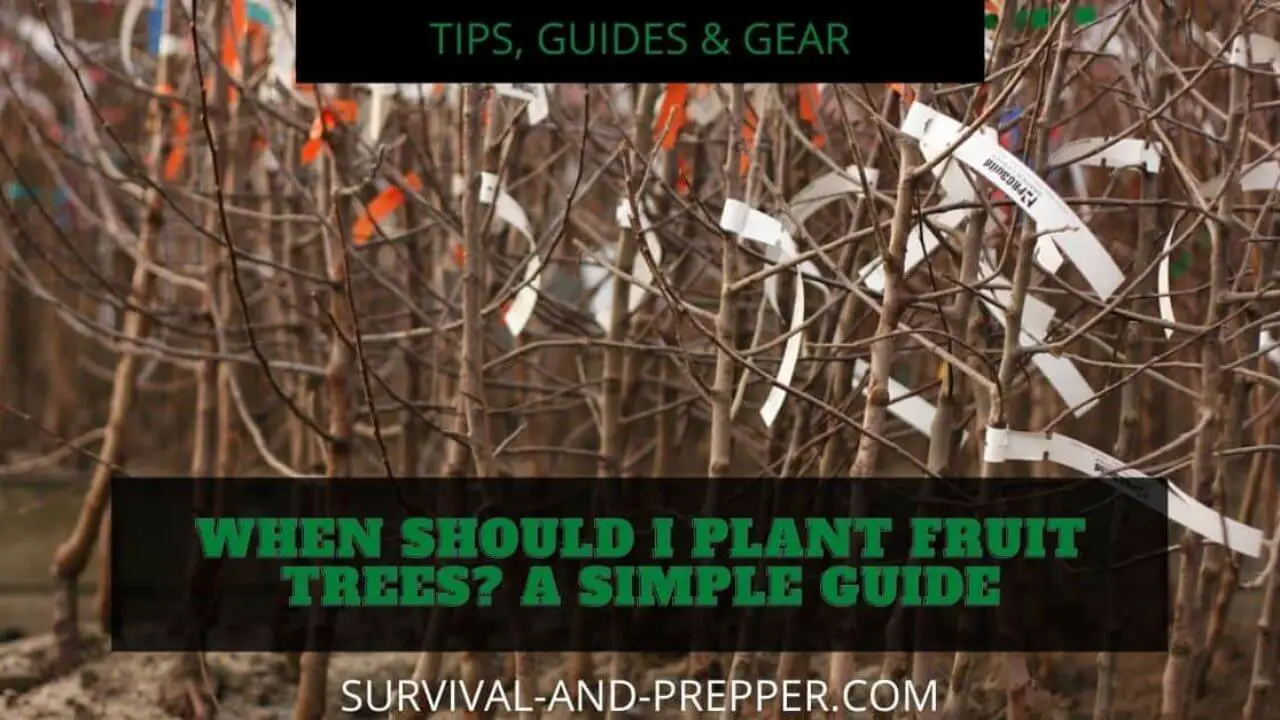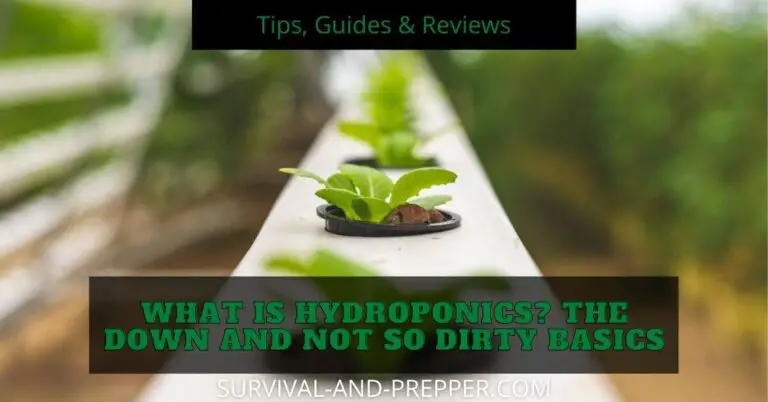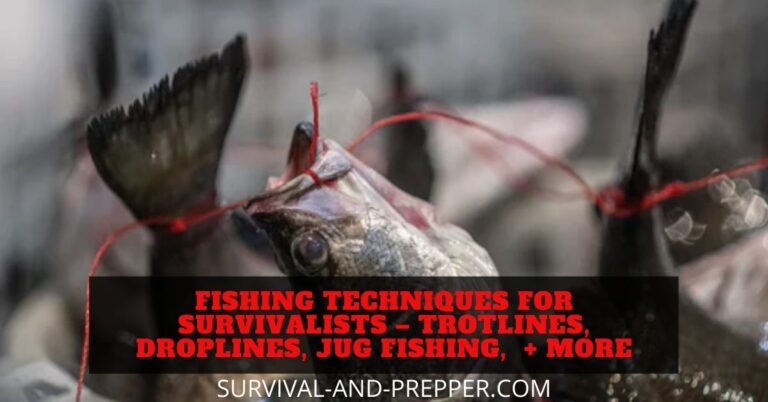When Should I Plant Fruit Trees? A simple Guide
Generally speaking the last part of winter and early spring are the best time to plant your fruit bearing trees and bushes. A simple way to tell is to check the local nurseries. If they have bare root fruit trees out then it’s time to plant.
Having multiple sources of food on your homestead is an excellent idea. Fruit trees and fruit producing bushes are one of many options, more importantly though these will produce year after year.
It is estimated for example that a mature apple tree can produce around 150 to 300 pounds of fruit per year. From one tree that is a significant amount of fresh fruit, jam, jelly, and applesauce among other things such as dried fruit.
Learn to dehydrate your own food.
By having several trees of different varieties not only can you produce food for your family but also have significant amounts left over to trade or sell.
Read on to get a basic understanding of starting your own fruit bearing orchard.
How Many Fruit & Berry Plants Per Person to Plant
When Should you Plant Your Fruit Trees
Most fruit trees that you buy as bare roots should be planted in late winter. You can go into early spring, but you want to make sure that they have time to get over the shock of transplanting before summer. This is due to the fact that fruit trees and most other plants need time to begin establishing their root systems before they grow their leaves and fruit.
As mentioned already your local nurseries will know what kind of trees do best in your area and they will also start setting them out when it is time to plant them. Another note to point out is have a short discussion with the staff there and describe your growth environment to them.
Even though a tree may thrive in your area it is possible that your particular soil or water conditions may suit a different variety better. They may also suggest a slightly different planting time, for instance blueberries and raspberries can be planted later in spring than some other fruits.

What is the Best Place to Buy Fruit Trees and Bushes
There are numerous options to find fruit trees in your area. Some include the big box stores such as Home Depot, Lowes, Menards and Ace Hardware; however you are generally better off going to a local nursery.
They tend to be somewhat more knowledgeable and have trees that are better suited for your area. This is due in large part to the fact that they focus only on plants and not everything under the sun. After all sheetrock will most likely not make for a better fruit tree.
Remember to take the time and meet with an experienced employee of the nursery to discuss your growing conditions and end goals. While you may know that you want apples, do you know specifically which of the nearly 7500 varieties available in the world that you want? Get some help from an expert in this area.
Another option for finding fruit bearing plants is to order them from online. While Amazon does sell fruit trees, I suggest instead that you contact a reputable online nursery. Some of these include Raintreenursury.com, Naturehills.com and Springhillnursury.com to name a few.
Most of these online nurseries will take the time to select plants that are healthy and properly package them so that you receive them in a like condition. If you check around you can find sites that have guarantees on the plant surviving for a specific amount of time as well.
Bare Root VS Potted
You can purchase bare root trees or potted fruit trees. Your needs will help you determine which is best.
Bare root trees will have the root ball but they will not have any soil. These must be planted in the winter and early spring at the latest so that they have time to establish. In the long term though, these tend to be stronger as they are planted when dormant and do not suffer as much shock. They also tend to be cheaper than other options.
Potted fruit trees tend to show up a little later and are intended to extend the planting season slightly. Since they have already begun their spring awakening. However, sometimes they can have issues due to the differences in the soil they are potted in vs the soil they are transplanted into. They tend to be slightly more expensive due to the extra materials and work involved.
Keep in mind that some fruit trees can live their whole lives in pots. These are generally the dwarf or semi dwarf variants. Keep in mind though that these will produce far less fruit than their full sized compatriots.
Selecting a Healthy Tree
If you are purchasing bare root trees then it can be more difficult to determine a healthy tree. This is why it is so important to work with a reputable nursery. This difficulty stems from the fact that you’re purchasing and planting them before they have grown leaves or blossoms.
Try to select a tree that has a decent set of limbs arranged in a fairly well-balanced manner. You also want to ensure the trunk appears stable and has no cracks or scarring on the bark.
Examine the root ball itself and try to avoid any that have the roots circling around. This could cause the roots to choke themselves later. Try to select a root ball that has the roots all running outwards.
Rooting a Fruit Tree Cutting
Another way to obtain your fruit trees is to root a small limb pruned from another tree. This involves cutting off a short piece of limb between 15 and 25 centimetres long, dipping that into a rooting hormone and then keeping it moist in a growing medium. Here is a more detailed article on that at the Permaculture Research Institute.
Shoots or Canes
Some plants such as many viney berries create off shoots or “canes”. These can be harvested and then planted. They will quickly sprout into their own plants. These types of plants often need to be thinned out every few years. Blackberries, raspberries and a few others fall into this category.
How You Should Plant Your Fruit Bushes and Trees
There are several considerations to keep in mind when planting your new trees. These include size at maturity, the size of hole you will need, possible implications of the roots, and watering considerations.
Size at maturity is probably your first consideration since it determines where you can plant your fruit trees. You need to make sure that you have ample room for your tree to grow and that it won’t, one be interfered with by other larger trees and two, it won’t interfere with other plants or structures in your homestead. Once that is determined you can select a proper location for the tree.
Its Planting Time
If you are moving an established fruit tree, potted tree or even a bare root tree you want to dig a whole that is about double the width and depth of your root ball.
Create a small pyramid of dirt in the bottom coming to a point about half way up the depth of your hole. Compact this as tightly as you can since you are planting a tree. Now sit your plant down in the hole spreading the roots around this cone shaped pyramid that you created. It is important that you consider how deep you are planting the tree.
Examining your root ball you want the highest root, or first significant root, in the bunch to be either at the top level of the surface soil or no more than an inch or so below this. If necessary add more dirt to the bottom of your hole to bring your tree up to this point. Examine your roots at this time, if there are any that appear broken go ahead and remove them now.
Back-fill your hole now using some compost and loose dirt. Many will suggest that you keep the soil at the level it was in the nursery, however this is not always the case. It is best to go off of the most significant root and keep that at or just below surface level.
Watering Your Fruit Trees
Build a small wall around the base of the tree that will allow the water to filter to the roots instead of running away on the surface. For this first watering go easy on the water and you can see where you may need to add a bit more soil.
Since these are most often being planted in the winter you do not want to over water them. In spring once the leaves begin to show you need to water them with about 5 to 10 gallons of water a week. This is best done on the same day instead of over the course of a few days. This ensures that the water penetrates deep enough into the ground to form stronger roots.
For the first few years of the tree’s life you want to keep up this watering schedule if it does not rain. Remember not as much water is needed in the fall and winter months. It is probably not a bad idea to water the tree once a week in the heat of the summer, even if it did rain just to ensure that it is getting sufficient water.
Planting From Seeds
Most often people plant bare root or potted fruit trees. However, it is possible to grow them from seeds. Keep in mind though that due to grafting, cross pollination and peculiarities to each particular plant there are times that the tree that grows from your seed will not be the same variety as its parent fruit.
This change depends on how the fruit pollinated as well as other characteristics. Some trees such as the PawPaw draw their genetic material only from the female parent and in these cases will produce nearly identical plants. In most cases though this is not true.
If you choose to plant from seeds then it is best to make sure that the seeds do not dry out after being harvested from the fruits. In many cases they will be fine but with citrus they tend to do better if they remain moist.
While it is possible to plant them directly into the ground, most people choose to plant seeds in small pots in late spring to early summer. As the seedlings sprout and begin to grow they are transferred to larger pots until they can be planted the following winter or early spring.
What do I Need To Know to Pick My Own Variety of Fruit
Various decisions go into picking the best variety of fruit for you to grow. Some of these are listed below. I am going to use apples for most of my examples since that is what I am most familiar with.
Do I like that type of fruit? There is not much point in planting a fruit tree if you don’t like to eat that particular fruit. So make sure you will like the fruit that is produced. With apples for example there are so many different textures and flavors that you may want to first try some apples of that variety to ensure you like the final product.
Do I plan to eat it only as fresh fruit or do I want to make jams, jellies etc? This is important since some varieties make better fresh fruit than canned or cooked. Make sure that the variety you pick will work for your desired goals. Pinkladies, Jonagold and Grannysmiths all have different characteristics despite all being a variety of apples.
What is my growing season? Different areas have different lengths of their growing season. This can vary even within the same zip code. For instance, in the mountains the growing season at a higher elevation will likely be shorter than the one in the valleys. Keep this in mind as some apples and other fruit trees become ripe at slightly different times.
Am I buying only one tree or multiple types and varieties? This is important due to the needs of plants to pollinate. Some varieties are self pollinating but may produce more fruit if they have another to cross pollinate. Surprisingly they often do better if they have a different variety to cross pollinate with.
Crabapples are an example of this. They bloom for a longer period of time than most apples allowing it to release pollen in early, mid and late seasons. While they are rarely eaten alone, due to their extreme bitterness, they are capable of cross pollinating nearly every other species of apple. The crabapples also contain a high level of pectin which is useful in setting your jams and jellies.
How much room do I have? This question determines if you can have multiple trees, as well as if you should pick a dwarf or semi dwarf variety. It could also determine if you need to focus on self pollinating trees to minimize the need for additional plants.
10 Examples of Bare Root Fruit Trees Best Planted in Winter
- Pears
- Pawpaw
- Apricot
- Apple
- Crabapple
- Sweet Cherry
- Sour Cherry
- Peaches
- Plums
- Oranges
10 Examples of Self-Pollinating Fruit Bearing Plants
- Most Citrus Plants
- Apricots
- Grapevines
- Pomegranate
- Strawberries
- Blackberries
- Sour Cherries
- Persimmons
- Some Species of Plums such as the European Plum
- Pears
10 Examples of Cross-Pollinating Fruits
- Apples
- Blueberries
- Some Species of Plums
- Most Nut trees fall into this category.
- Pears
- Sweet Cherries
- Most varieties of Plums
- Muscadines
- Elderberries
- Pineapples
Additional Information
Keep in mind that fruit trees take time.In most cases it will take between 4 and 7 years before your trees produce a large harvest. While some bare root plants may be several years old already you should ask your nursery if they can provide that information. Generally the larger the plant the older it is. Some plants such as Raspberries can begin producing fruit the following year.
Grafting is often performed on trees in order to get desirable characteristics. One example of this that you may have seen is “fruit cocktail trees”. These are trees where several varieties of fruit have been grafted onto the same tree. I have seen mixed reviews on these and prefer to stick with one fruit per tree, though they may be an option if you have limited space.
Dwarf and Semi Dwarf trees are generally produced by grafting the desired fruit onto a dwarf or semi dwarf root stock. This produces trees that are smaller in nature. While they will not produce as much fruit they are a decent option for limited space.
I hope you enjoyed the article and found the information you were looking for. Be sure to sign up for our monthly newsletter to receive the latest tips and articles along with discount codes periodically.






One Comment